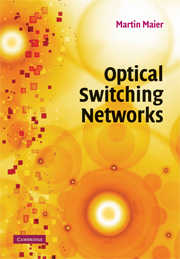Book contents
- Frontmatter
- Contents
- List of illustrations
- List of tables
- Preface
- Acknowledgments
- Part I Introduction
- Part II Optical wide area networks
- Overview
- 5 Generalized multiprotocol label switching
- 6 Waveband switching
- 7 Photonic slot routing
- 8 Optical flow switching
- 9 Optical burst switching
- 10 Optical packet switching
- Part III Optical metropolitan area networks
- Part IV Optical access and local area networks
- Part V Testbeds
- Bibliography
- Index
8 - Optical flow switching
from Part II - Optical wide area networks
Published online by Cambridge University Press: 10 May 2010
- Frontmatter
- Contents
- List of illustrations
- List of tables
- Preface
- Acknowledgments
- Part I Introduction
- Part II Optical wide area networks
- Overview
- 5 Generalized multiprotocol label switching
- 6 Waveband switching
- 7 Photonic slot routing
- 8 Optical flow switching
- 9 Optical burst switching
- 10 Optical packet switching
- Part III Optical metropolitan area networks
- Part IV Optical access and local area networks
- Part V Testbeds
- Bibliography
- Index
Summary
In the previous section, we have seen that photonic slot routing (PSR) can be transformed into individual wavelength switching (IWS) and used to realize synchronous optical packet switching (OPS) networks with the restriction that packets need to be of fixed size. Unlike electronic IP packet switching networks, these OPS networks require network-wide synchronization and are able to transport only fixed-size packets. In contrast, IP networks do not require network-wide synchronization and support variable-size IP packets. In addition, contention resolution can be done more easily and more efficiently in electronic networks than in optical networks by using electronic random access memory (RAM). Packets contending for the same router output port can be stored in electronic RAM and sent sequentially through the same port without collision. In optical networks, RAM is not feasible with current technology. Instead, bulky switched delay lines (SDLs) and/or inefficient deflection routing need to be deployed in order to resolve contention in OPS networks. Clearly, electronic packet-switched networks are able to resolve contention more efficiently by using electronic RAM. Given the steadily growing line rates and amount of traffic, however, electronic routers may become the bottleneck in high-speed communications networks that use electronic routers for storing and routing and optical fiber links for transmitting packets of variable size. This bottleneck is commonly referred to as the electro-optical bottleneck.
One of the main bottlenecks in today's Internet is (electronic) routing at the IP layer. Several methods have been proposed to alleviate the routing bottleneck by switching long-duration flows at lower layers (e.g., GMPLS; see Chapter 5). In doing so, routers are offloaded and the electro-optical bottleneck is alleviated.
- Type
- Chapter
- Information
- Optical Switching Networks , pp. 95 - 102Publisher: Cambridge University PressPrint publication year: 2008



